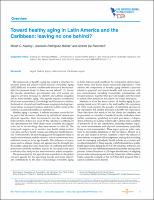Toward healthy aging in Latin America and the Caribbean: leaving no one behind?
Date
2021ISSN
1680 5348
Metadata
Show full item recordOther Language Versions
Abstract
The framework of healthy aging has created a structure for research across the United Nations Decade of Healthy Aging (2021-2030) and for action to address the mission of the Sustain-able Development Goals “to leave no one behind”. Across the decade, researchers, governments and civil society are urged to develop strategies to identify and address inequities and to foster healthy aging. This agenda requires coordinated effort from researchers in Gerontology and Geriatrics to address the broad set of social and health issues in aging including functional status, social participation, and older adults’ needs in the context of social and health care systems.
Subject
Citation
Keating NC, Rodríguez Mañas L, De Francisco A. Toward healthy aging in Latin America and the Caribbean: leaving no one behind? Rev Panam Salud Publica. 2021;45:e113. https://doi.org/10.26633/RPSP.2021.113
Collections
This notice should be preserved along with the article's original URL.Attribution-NonCommercial-NoDerivs 3.0 IGO
Related items
Showing items related by title, author, creator and subject.
-
Galvão, Luiz Augusto C. (Ed.); Finkelman, Jacobo (Ed.); Henao, Samuel (Ed.) (PAHOUnited StatesWashington, D.C., 2016)[Prologue - Carissa F. Etienne]. In the “Era of Sustainable Development,” health is an essential input and the most valuable human development outcome. Achieving the best health outcomes involves tackling the environmental ...
-
Rosenberg, Félix; Tobar, Sebastián; Buss, Paulo (2015)El presente artículo analiza el papel que desempeñaron los institutos nacionales de salud de la Unión de Naciones Suramericanas (UNASUR) desde su creación a inicios del siglo hasta la actualidad, para luego postular como ...
-
Pan American Health Organization (PAHOUnited StatesWashington, D.C., 2006)[Introduction] Despite being the period of most rapid growth second only to infancy, nutritional problems during adolescence (defined by WHO as between 10-19 years of agea) in developing countries have been largely ignored ...





